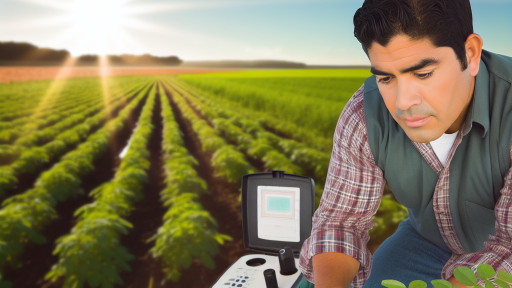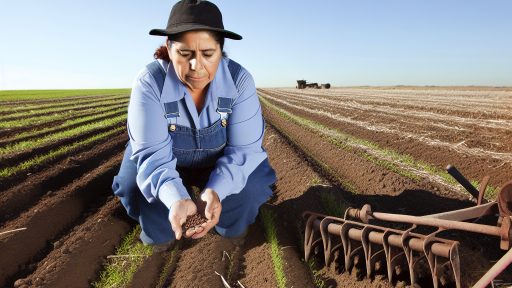Introduction to Organic Crop Planning
Organic crop planning plays a vital role in sustainable agriculture.
It ensures farmers can produce healthy crops throughout the year.
This planning method emphasizes environmental stewardship and soil health.
Moreover, it helps meet the increasing consumer demand for organic products.
Importance of Organic Crop Planning
Effective planning leads to higher yields and resource efficiency.
It maximizes the use of available land and nutrients.
Farmers can also see a reduction in pest issues through diverse planting.
This method supports crop rotation and reduces dependency on chemical inputs.
Benefits of Organic Crop Planning
Organic crop planning enhances biodiversity on farms.
This approach contributes to improved soil structure and fertility.
Farmers can also reduce costs by minimizing chemical usage.
Additionally, organic crops often fetch higher market prices.
Implementing Year-Round Strategies
Year-round planning involves selecting crops based on seasons.
Farmers can choose varieties that thrive in different conditions.
Cover crops play a crucial role in maintaining soil health during fallow periods.
Transform Your Agribusiness
Unlock your farm's potential with expert advice tailored to your needs. Get actionable steps that drive real results.
Get StartedUsing mulch can also help retain moisture and suppress weeds.
Understanding Seasonal Crop Cycles for Year-Round Production
Significance of Crop Cycles
Understanding crop cycles is crucial for successful farming.
It allows farmers to optimize planting and harvesting times.
Moreover, knowing these cycles helps in resource management.
Effective crop planning can increase yields sustainably.
Farmers can reduce wastage by aligning crops with their growth stages.
Identifying Growing Seasons
Different crops have unique growing seasons.
Temperature, light, and moisture influence these periods.
Regions vary significantly in growing conditions.
This variance necessitates tailored approaches for each area.
Farmers should monitor local climatic trends regularly.
Crop Rotation Strategies
Implementing effective crop rotation enhances soil health.
Rotating crops reduces pest infestations and diseases.
It allows nutrients to replenish effectively in the soil.
Farmers should prioritize nitrogen-fixing crops for soil enrichment.
Plan rotations to ensure diverse planting throughout the year.
Companion Planting Benefits
Companion planting can significantly boost crop success.
Certain plants naturally deter pests and enhance growth.
Strategically pairing crops maximizes space and resources.
This method encourages a balanced ecosystem in the garden.
Farmers should experiment with different combinations for best results.
Adapting to Climate Variability
Climate change affects seasonal patterns and crop cycles.
Farmers must adapt their strategies to these changes.
Innovative techniques can mitigate adverse effects on crops.
Showcase Your Farming Business
Publish your professional farming services profile on our blog for a one-time fee of $200 and reach a dedicated audience of farmers and agribusiness owners.
Publish Your ProfileUtilizing technology can help monitor and predict climate impacts.
Staying informed allows for timely adjustments in planning.
Selecting the Right Organic Varieties for Different Seasons
Understanding Seasonal Planting
Choosing the right planting time is crucial for success.
Different crops thrive during specific seasons.
Understanding these cycles increases yield potential.
Spring Varieties
Spring provides ideal conditions for many crops.
Cool-season crops like lettuce and spinach flourish now.
Planting these early ensures they mature before summer heat.
Consider including radishes and peas for quick harvests.
Summer Varieties
Summer brings warmth and longer days for growth.
Heat-loving crops include tomatoes, peppers, and cucumbers.
These varieties require ample sunlight and regular watering.
Additionally, plant basil and zucchini for diverse options.
Fall Varieties
As temperatures cool, certain crops perform well.
Fall is perfect for planting root vegetables like carrots and beets.
Consider also planting kale and Swiss chard for winter harvests.
These crops can withstand cooler temperatures.
Winter Varieties
Winter may seem challenging, but some crops thrive.
Cold-tolerant crops like garlic and shallots benefit from winter planting.
Covering soil with mulch protects these crops from the frost.
In addition, consider growing sprouts indoors for year-round production.
Crop Rotation Strategies
Implementing crop rotation ensures soil health.
Rotate crops each season to break pest cycles.
This method enhances biodiversity and nutrient availability.
For example, follow legumes with heavier feeders like corn.
Finding Reliable Seeds and Varieties
Sourcing high-quality organic seeds is vital.
Choose well-known suppliers who specialize in organic varieties.
Check for local seed exchanges to find adapted varieties.
Consider heirloom varieties for unique flavors and resilience.
Discover More: Soil Health 101: Techniques to Boost Crop Growth Naturally
Soil Health Management and Fertility Practices for Organic Farming
Importance of Soil Health
Soyl health plays a crucial role in organic farming.
Healthy soil supports plant growth and enhances yield quality.
It also fosters biodiversity and ecological balance.
Additionally, healthy soil improves water retention and nutrient availability.
Assessing Soil Conditions
Regular soil testing helps farmers understand their soil’s health.
Conduct tests for pH, nutrient levels, and organic matter content.
These assessments guide soil management practices effectively.
Soil Testing Methods
There are various methods for testing soil health.
- Laboratory analysis provides accurate results.
- DIY soil test kits offer a quick assessment.
- Field observations can reveal signs of soil distress.
Improving Soil Fertility
Organic farming relies on natural fertility-building practices.
Crop rotation is an effective method to enhance soil nutrients.
Showcase Your Farming Business
Publish your professional farming services profile on our blog for a one-time fee of $200 and reach a dedicated audience of farmers and agribusiness owners.
Publish Your ProfileIncorporating cover crops can reduce erosion and improve soil structure.
Furthermore, adding organic matter enriches the soil.
Using Organic Amendments
Organic fertilizers and amendments boost soil fertility.
- Compost enriches soil with nutrients and beneficial microorganisms.
- Bone meal adds phosphorus for root and flower development.
- Green manure provides nitrogen and organic matter.
Pest and Disease Management
Maintaining soil health also helps manage pests and diseases.
Healthy soil fosters plant resilience against various threats.
Use crop diversity to disrupt pest cycles effectively.
Continuous Improvement Strategies
Implementing no-till farming improves soil structure and reduces erosion.
Incorporating permaculture principles can enhance productivity sustainably.
Regularly updating soil management practices is essential.
Engage with local resources and organic farming networks for support.
Discover More: Unlocking the Secrets of Crop Rotation for Year-Round Yield
Crop Rotation Strategies to Enhance Soil and Crop Health
Understanding Crop Rotation
Crop rotation involves changing the type of crop grown in a particular area from season to season.
This practice helps to break pest and disease cycles.
Moreover, it improves soil fertility and structure.
Benefits of Crop Rotation
Implementing crop rotation offers numerous advantages for sustainable farming.
-
It enhances soil health by alternating nutrient demands.
-
Crop diversity encourages beneficial microorganisms in the soil.
-
Rotating crops reduces reliance on chemical fertilizers and pesticides.
-
It helps prevent soil erosion by maintaining ground cover.
Effective Crop Rotation Plans
Developing effective crop rotation plans requires consideration of various factors.
-
Start by assessing the nutrient needs of different crops.
-
Consider the planting and harvesting times for each crop variety.
-
Incorporate legumes to fix nitrogen in the soil.
-
Include cover crops during fallow periods to retain soil moisture.
Long-term Practices for Success
Maintaining a successful rotation over the years requires careful monitoring.
Track the performance of each crop and adapt your plan accordingly.
Additionally, allow for flexibility based on market demands and climate conditions.
Regular soil testing ensures balanced nutrient levels and identifies deficiencies.
Integrating Cover Crops
Integrate cover crops into your rotation for added soil benefits.
-
Cover crops prevent soil compaction during the off-season.
-
They improve organic matter content as they decompose.
-
Furthermore, cover crops enhance soil moisture retention.
Real-World Examples
Farmers across the globe are adopting crop rotation strategies.
For instance, Ethan Carter uses corn-soybean rotation effectively.
This method has increased his yield while reducing input costs.
Similarly, Leah Martinez incorporates rye and clover in her plan.
Her practice has improved soil texture and fertility remarkably.
Gain More Insights: Maximizing Crop Health: Why Micronutrients Matter More Than Ever
Integrating Cover Crops to Improve Soil Structure and Reduce Erosion
The Role of Cover Crops
Cover crops play a vital role in maintaining soil health.
They enhance soil structure by promoting aggregation.
Moreover, they contribute organic matter to the soil.
This organic matter improves moisture retention.
In addition, it boosts nutrient availability for subsequent crops.
Benefits of Cover Crops
- Minimize soil erosion through root development.
- Shields the soil from the impact of rain and wind.
- Facilitates nutrient cycling within the ecosystem.
Furthermore, cover crops suppress weed growth effectively.
This reduction in weeds decreases competition for resources.
Ultimately, they can lead to better crop yields.
Choosing the Right Cover Crops
Selecting the appropriate cover crops is critical.
Many factors influence this choice, including climate and soil type.
For instance, leguminous cover crops fix atmospheric nitrogen.
This process enhances nitrogen availability in the soil.
In contrast, brassicas improve soil structure with deep taproots.
Showcase Your Farming Business
Publish your professional farming services profile on our blog for a one-time fee of $200 and reach a dedicated audience of farmers and agribusiness owners.
Publish Your ProfileImplementing Cover Crops
Integrating cover crops into rotations requires planning.
Farmers should choose planting and termination dates wisely.
Timing ensures that cover crops benefit the soil without interfering with main crops.
Additionally, tillage practices must adapt to the use of cover crops.
Monitoring and Evaluation
Regular monitoring of cover crop effectiveness is essential.
Farmers can assess changes in soil properties over time.
This assessment helps refine future cover crop selections.
Moreover, it promotes ongoing learning and adaptation in farming practices.
Uncover the Details: The 7 Best Practices for High-Yield Corn Cultivation

Pest and Disease Management in Organic Crop Planning
Importance of Pest and Disease Management
Pest and disease management is vital for organic crop health.
This practice enhances yield and ensures sustainable farming.
Furthermore, it reduces reliance on synthetic chemicals.
Identifying Pests and Diseases
Begin by regularly monitoring your crops for signs of pests.
Look for unusual discoloration, wilting, or leaf damage.
Use identification guides to accurately determine the type of pest or disease.
Preventive Strategies
Employ crop rotation to disrupt pest life cycles.
Choose disease-resistant crop varieties to minimize risks.
Furthermore, practice good sanitation by removing debris and infected plants.
Biological Control Methods
Leverage beneficial insects, such as ladybugs, to control aphid populations.
Introduce nematodes to combat soil-borne pests effectively.
Additionally, use microbial pesticides like Bacillus thuringiensis to target specific pests.
Cultural Control Techniques
Implement intercropping to confuse pests and enhance biodiversity.
Adjust planting timelines to evade peak pest populations.
Mulching can also suppress weeds and provide habitat for beneficial organisms.
Monitoring and Evaluation
Regularly assess crop health to catch issues early.
Keep detailed records of pest populations and disease occurrences.
Adjust your strategies as needed based on this data.
Collaboration and Knowledge Sharing
Join local farming co-ops to share information on pest management techniques.
Attend workshops and training sessions to stay informed about new practices.
Networking with other organic farmers fosters community support and knowledge exchange.
Utilizing Technology and Tools for Efficient Organic Crop Management
Implementing Precision Agriculture
Precision agriculture enhances crop yields through data analysis.
This technology utilizes sensors and GPS mapping.
Farmers gain insights about soil conditions and crop health.
Consequently, they can make informed decisions on resource use.
Efficient water management reduces waste and increases sustainability.
Leveraging Crop Management Software
Crop management software helps farmers plan effectively.
These tools track planting schedules and harvest timelines.
They also monitor crop progress throughout the season.
Farmers can analyze data trends and make adjustments as needed.
As a result, they achieve better alignment with market demands.
Showcase Your Farming Business
Publish your professional farming services profile on our blog for a one-time fee of $200 and reach a dedicated audience of farmers and agribusiness owners.
Publish Your ProfileUsing Mobile Applications
Mobile apps provide farmers with real-time information.
Farmers can access weather data and pest alerts instantly.
This information enables timely interventions in crop management.
Furthermore, apps can offer networking opportunities with experts.
Farmers can share insights and gain advice from peers.
Adopting Automated Irrigation Systems
Automated irrigation systems promote water conservation.
These systems use sensors to determine soil moisture levels.
Consequently, irrigation occurs only when necessary.
This practice prevents over-watering and conserves resources.
Additionally, it supports healthier crop growth and regeneration.
Integrating Drones into Farming
Drones offer unique perspectives on crop health and growth.
They can detect plant stress, pest infestations, and variations in growth.
Farmers can use this data to target interventions effectively.
Moreover, drones enable monitoring of large areas quickly.
This technology streamlines the evaluation process for farmers.
Marketing Organic Crops: Strategies for Successful Sales Year-Round
Identifying Your Target Market
Understand the specific needs of your potential customers.
Identify local restaurants that emphasize organic ingredients.
Explore the preferences of health-conscious consumers.
Attend farmers’ markets to get direct feedback from buyers.
Use online surveys to gather insights about customer preferences.
Creating a Compelling Brand
A strong brand sets your products apart from competitors.
Design an eye-catching logo that reflects your values.
Craft an engaging story about your farming practices.
Ensure your packaging communicates organic certification clearly.
Consistently use your branding across all marketing channels.
Utilizing Social Media Marketing
Engage with customers on platforms like Instagram and Facebook.
Share visually appealing photos of your crops and farm.
Post regular updates about seasonal offerings and promotions.
Encourage satisfied customers to share their experiences online.
Use targeted ads to reach potential customers effectively.
Developing Relationships with Local Businesses
Partner with local grocery stores and co-ops for distribution.
Offer samples of your products to entice buyers.
Organize farm-to-table events to connect with local chefs.
Provide educational workshops about organic farming.
Collaborate with other local farms to expand your reach.
Implementing Seasonal Marketing Strategies
Plan promotions that align with seasonal crop availability.
Grow crops that thrive in different seasons for constant supply.
Offer subscription boxes that deliver seasonal produce directly.
Host events during peak harvest times to attract visitors.
Utilize holiday themes in marketing campaigns throughout the year.
Showcase Your Farming Business
Publish your professional farming services profile on our blog for a one-time fee of $200 and reach a dedicated audience of farmers and agribusiness owners.
Publish Your ProfileMaintaining Customer Engagement
Follow up with customers after their purchases.
Send out newsletters highlighting new products and recipes.
Implement a loyalty program to reward repeat customers.
Seek feedback to improve your offerings consistently.
Engage online through interactive content and polls.
Long-term Planning for Sustainable Organic Farming
Establish Clear Goals
Setting clear goals is essential for successful organic farming.
Identify what you want to achieve in your farming practice.
Goals can include crop yields, soil health, or environmental stewardship.
Each goal should be specific, measurable, attainable, relevant, and time-bound.
Create a Comprehensive Crop Calendar
A crop calendar helps you plan planting and harvesting seasons effectively.
It allows you to align crops with their optimal growing conditions.
Include key dates such as planting, fertilizing, and harvesting times.
Regularly update the calendar based on weather patterns and soil conditions.
Implement Crop Rotation Strategies
Crop rotation enhances soil fertility and reduces pest pressures.
Changing the type of crops grown in a given area each season is vital.
Plan rotations that include legumes, which fix nitrogen in the soil.
Consider companion planting to maximize crop health and yields.
Focus on Soil Health
Soil health is foundational to sustainable organic farming.
Regularly monitor soil quality through testing and assessment.
Incorporate organic matter, such as compost, to improve soil structure.
Utilize cover crops to prevent erosion and enhance soil nutrients.
Utilize Sustainable Pest Management
Adopt integrated pest management practices for sustainable solutions.
Implement biological controls, like introducing natural predators to pests.
Use organic pesticides only when necessary and as a last resort.
Track pest populations and adjust strategies accordingly for effectiveness.
Engage with Community Resources
Building connections with local farmers enhances successful practices.
Join organic farming networks to share knowledge and resources.
Attend workshops and seminars focused on organic agriculture.
Leverage community support to enhance your farming methods.
Continuously Assess and Adapt
Ongoing assessment is crucial for long-term success.
Regularly review crop performance, resource use, and environmental impact.
Adapt strategies based on data to improve productivity.
Stay informed about new research and practices in organic farming.




